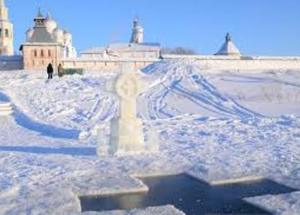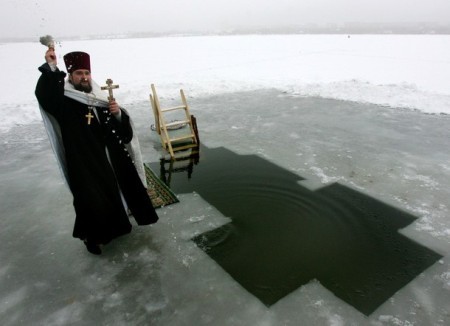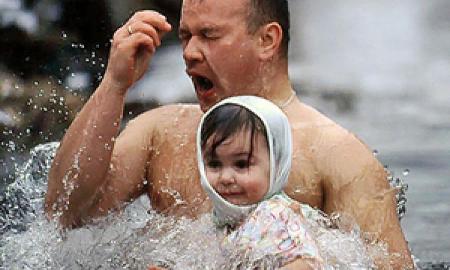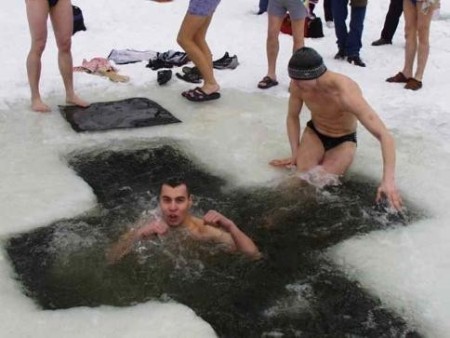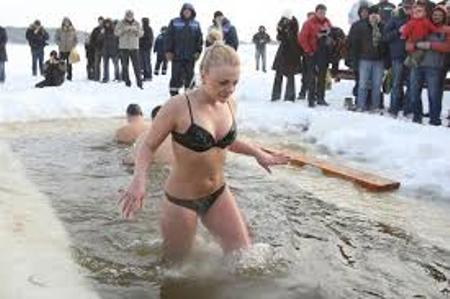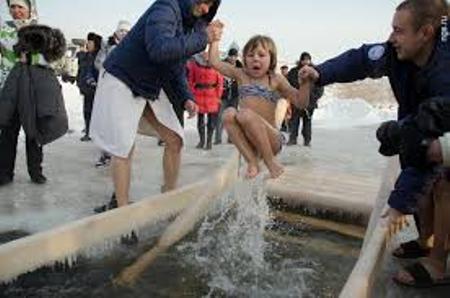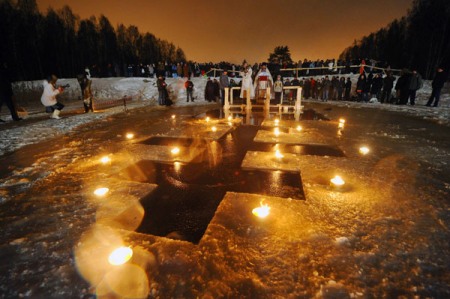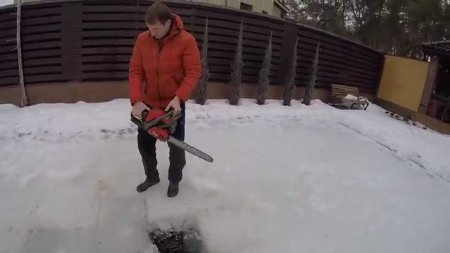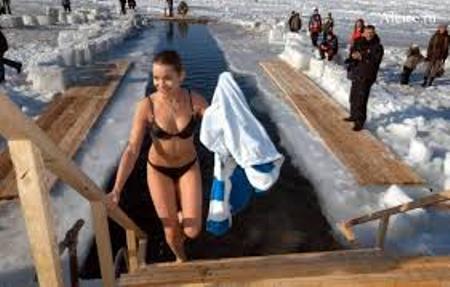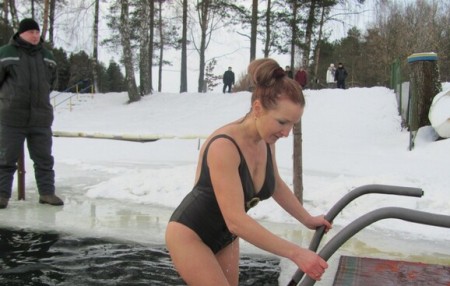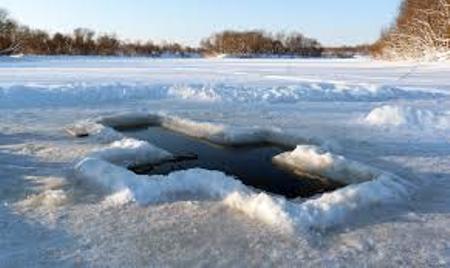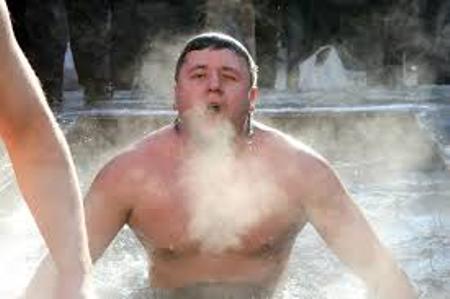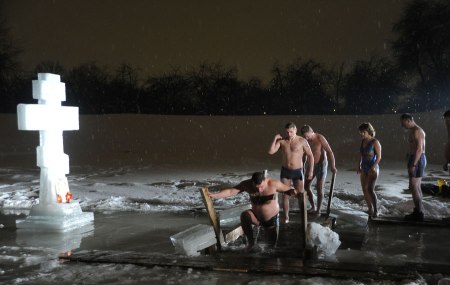The ceremony of Epiphany bathing began to gain popularity among believers from around the tenth century. after the Baptism of Russia. Epiphany baths are produced in water reservoirs, in specially cut openings, which are consecrated by the priest before the beginning of the ceremony by tripling the cross in the hole and reading the prayers. Sanctification of water is made after the solemn liturgy. Sanctified water is considered curative.
Content
The process of baptismal bathing - when and how it is performed
If you follow the canons, then on the day of the Epiphany Eve the believer should go to the temple, defend the festive service, put a candle. Before going to the church, you should stock up with a clean, empty container - you can collect consecrated water. Obligatory bathing in the ice-hole, in ice water, the church does not provide, especially if a person is prepared physically and spiritually for such a method of purification.
Nevertheless, to plunge into the sacred Jordan, the so-called cross-shaped ice-hole, becomes year by year more. In cities, specially prepared for Epiphany ice hole, which allows a massive bathing of believers.
There are no special rules for swimming in the ice-hole. They usually perform a triple immersion, with their heads, while they are baptized and say: "In the name of the Father, and the Son, and the Holy Spirit!".
Epiphany bathing is credited with healing properties, in fact, a person during the immersion in water experiences stress and receives a portion of the positive energy that the water exudes. Special preparation for such an action is not required, the body has enough resources to independently cope with sudden changes in the temperature of the environment.
Wellness effects when immersed in an ice font provide:
- the awakening of the central nervous system, its active influence on brain activity,
- the body's short-term stress from the effects of low temperature helps to get rid of puffiness, spasms, inflammation,
- hardening, which provides a special property of water - its thermal conductivity is 28 times higher than the thermal conductivity of air, which is not capable of cooling the body so effectively,
- contact with ice water leads to a sharp rise in body temperature, to about +40 C, and at this temperature, instantaneous death of most pathogens and disease-affected cells occurs.
When bathing in the Jordan should follow such simple rules:
- bathing should be carried out in specially equipped places, near the shore, preferably under the supervision of rescuers,
- before you plunge into an ice-hole you should warm up, after running a jog or gymnastic exercises,
- to prevent loss of sensitivity by the feet it is desirable to approach the Jordan in shoes, these can be slippers with a non-slip sole, shoes or even woolen socks,
- go to the ice-hole should be slowly, remembering that snow and ice have a slippery surface,
- before you start on the stairs you should make sure that it is secured well, it is advisable to hedge and lower the edge of a thick rope into the water - if necessary, the bathers will be able to use it to enter the ice, the second end of the rope should be firmly fixed on the shore of the reservoir,
- it is not advisable to dive into the water, doctors do not recommend diving right away - sudden hypothermia of the brain can cause a reflex narrowing of the vessels, it is not recommended to jump into ice water at all,
- entering the water for the first time to swim should not be - it is desirable just to go to the required depth,
- so that the supercooling of the body is not too large, one should not stay in the water for more than 50-60 seconds,
- if the hole has a small size, but the depth of the pond is large, it will be necessary to pay special attention to the very process of immersion in water and to make it strictly vertically - if you shift toward the ice edge there is a threat to hit it with your head when surfacing,
- if a child swims in an ice hole - do not leave it for a minute without adult supervision - the child may be scared, even if it swims well,
- when leaving the font, you should hold on to the handrails, immediately wrap yourself in a dry terry towel, it is recommended to make the exit energetically.
Wipe after bathing should immediately wear warm clothes. It is also recommended to drink hot tea, best of all - brewed in a thermos.
Who is not recommended to swim in the ice
Only in principle healthy people can swim in the ice-hole. It is dangerous to deal with such extreme water procedures for people with chronic inflammatory diseases of the nasopharynx, middle ear.
Do not feel your endurance to those who suffer from serious diseases:
- cardiovascular,
- central and peripheral nervous systems,
- diseases of the organs of vision or endocrine system,
- tuberculosis,
- among the contraindications should remember asthma, diseases of the genitourinary organs, stomach ulcers, skin and venereal diseases.
What accessories should I bring with me for bathing at Epiphany?
When you are going to take ablution with ice water in an ice-hole, do not forget to take with you:
- slippery slippers or woolen socks,
- bathing suit and a rubber cap,
- bathrobe and towel, dry clothes.
How to equip an ice-hole for safe bathing on Epiphany holidays
The correct structure of a hole in the pond is a very important issue, and its competent solution will help to prevent the possibility of injuries during Epiphany bathing, and also to completely eliminate the threat of accidents.
When preparing the ice hole, you should pay attention to the following points:
- ensuring discipline among those wishing to adopt water procedures,
- responsible attitude of the organizers of the event,
- control by the health authorities,
- good preparation and serviceability of rescue equipment,
- and, most importantly, the proper preparation of the hole.
When equipping the hole, it is necessary to take into account:
- temperature indices of air,
- depth of the body of water in the place of the organization of the hole,
- the dimensions of the ice-hole and its shape,
- the distance from the place of bathing to the heated space,
- if bathing will occur in the river, then it is desirable to know the speed of the current.
It is recommended that the flow rate in the reservoir does not exceed 0. 25 m per second. The place of bathing should not be located near the piers, the points of confluence of rivers, downpipes, there should be no seaweed on the bottom of the reservoir. It is recommended to check the thickness of the ice - it should be at least a quarter of a meter.
Organizers should ensure that during bathing in the ice hole on the ice near her there were no more than 20 people. If the thickness of the ice is somewhat less, then you can make a hole for swimming, but on the ice near the ice hole there may be a minimum number of people.
Ideal option will be a hole with a clean sandy bottom, without algae and foreign objects on the bottom, debris or rocks. It is also not recommended to construct a hole in places of steep slopes of the bottom of the reservoir. The shore should not prevent the movement of people in different directions, the ice should be located so as to provide maximum protection from the wind.
Experience shows that the size of the ice-hole should be at least 12 square kilometers. meters. Such dimensions will be enough for swimming a maximum of 5 people. Clearing such a hole is easy enough to make a lot of effort to maintain it in the proper order is not required. A hole with dimensions smaller than 3x3 m is not recommended.
As for the depth of the Jordan, then there are different opinions:
- experienced bathers like deep places, from 2 to 3 m - when swimming, you do not need to step to the bottom, i.e., the risk of injury is reduced to zero, the water in such holes is cleaner, the silted bottom also does not cause distress to the bathers - to become on it surface is not required,
- small holes are preferred by those who can not swim, beginners, people of advanced age.
The shape of the ice-hole can be round or rectangular, baptismal bathing is most often organized in a cross-shaped ice-hole. It is quite easy to remove ice from it, it is also easy to organize the correct way out from the ice-hole - it will be enough to cut a notch along the ice edge and install a ladder.
The work should begin with the cleaning of the site chosen for the ice-hole, the approach to the water should be organized from all sides, so that the site should be more than a hole in the ice several times. Next, the outline of the ice hole on the ice is traced. The felling begins with a uniform deepening of all sides along the intended line.
It is not recommended to allow full ice cutting in one place - water will come out, flood the groove and complicate the further process. Throughout the perimeter of the hole it is recommended to leave the jumpers - they will be able to stop the water that emerged on any site.
The width of the cut groove should be about half the thickness of the ice. With the groove deepening it can be started to narrow, this option will simplify the work, too narrow groove will complicate the whole process.
The dimensions of the plates cut from the ice should be such that they are not difficult to drown and poke under the edges of the ice hole, or to pull it to the surface of the ice cover. For work with ice, the thickness of which exceeds 20 cm, longitudinal saws can be used. Thinner ice involves cutting down larger slabs.
Perform the work should be a team consisting of at least 5 or 6 people - the most convenient option - when two people pritaplivayut one of the edges of the ice floe, the rest - with hips tuck it under the ice edge, as far as possible. The edges should not protrude outward, and when the wave appears, the ice floe should not leave its location. This option is considered the most economical.
If the ice is very thick, then it becomes much more difficult to cope with ice floes dodging ice. In this case, the ice floes are crushed and lifted to the ice surface, they are removed for a distance of 4-5 m from the ice hole. Pile ice near the ice-hole is not allowed - this can create a situation dangerous for the health of people swimming.
Observations carried out on open water bodies have shown that at a temperature of the order of -20 C, water will be covered with an ice crust 2 or 3 cm thick overnight, and it takes about a week to form an ice cover 15 cm thick.
To clear ice (thickness of 15 cm), an ice-hole with an area of 10 square meters will take about an hour and a half time, provided that there will be two experienced people with special tools. At the edge of the ice hole it is necessary to freeze comfortable wooden staircases, best of all with handrails.
If the ladder is metal, then its steps and handrails should be wrapped tightly with a keeper's tape, or put a rubber hose of appropriate thickness on them.
If during the preparation of the ice hole, the instruments are flooded, they should be removed to the surface, except when the depth of the reservoir is more than 3 m.
For the convenience of bathers, the ice-hole is enclosed by a wall made of snow blocks, and a cloakroom can also be built from them. The snow wall protects the ice hole from gusts of wind. Install any fencing around the ice hole, from snow blocks, wooden shields or ice blocks, should be at a distance of 7 to 10 m from the ice edge. On the perimeter of the ice hole it is also desirable to install a light fence - so that people watching the bathing process can not accidentally fall into the water. If possible, the fence is installed in the water - this will prevent the possibility of getting bathers under the ice.
It should also take care of the organization of illumination of the ice-hole, but to comply with the rules of fire and electrical safety is mandatory.
In order to prevent the possibility of accidents near the Epiphany, it is necessary to establish a watch:
- representatives of law enforcement agencies,
- brigade of rescuers,
- physicians who, if necessary, are able to provide first aid.
During Epiphany bathing, you can not allow the arrival of ice on motor vehicles.
Clearing ice-hole from ice is made just before bathing.


